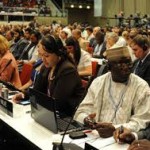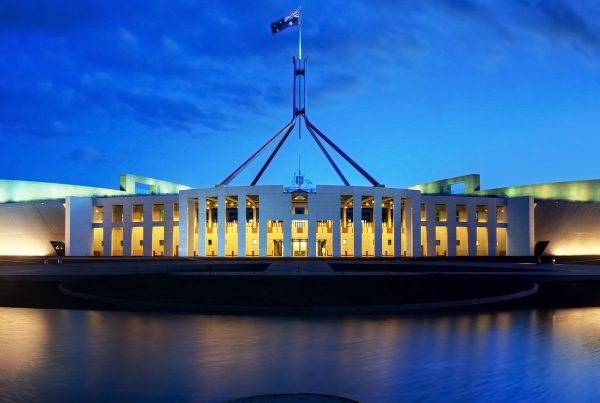Following on from last weeks’ entry about the climate change talks in Durban some progress was actually achieved on the environmental sustainability front with attendees agreeing that something-should-be-done about climate change, as opposed to predictions that nothing would be delivered.
Ben Cubby (below) takes the view that whilst China, India, the US and the EU have all agreed to a joint deal that seeks to cut emissions collectively, the actual work of cutting emissions has yet again been delayed.
John Connor (below) presents an interesting opinion piece on what the outcomes of the Durban talks will mean for domestic politics in Australia.
The Financial Times (below) stressed the effort attendees were making, against the odds, to deliver a result.
As a result of Durban, the carbon debate, environmental management and environmental sustainability should remain firmly on the Australian political radar in 2012 as all political parties will attempt to position themselves around the new found international consensus regarding action around climate change.
Durban pact at least creates climate for a binding deal
Ben Cubby
December 12, 2011
Opinion
Red-eyed delegates snatched naps in corridors, chartered flights were held back and the press room’s photocopier broke down, as UN climate talks in South Africa finally ground to a close yesterday at 5am local time – 35 hours behind schedule.
The product of the frenzied final hours is the so-called Durban Platform, an agreement to extend the Kyoto Protocol and then replace it with a more wide-ranging deal to cut greenhouse gases by the end of this decade.
with a more wide-ranging deal to cut greenhouse gases by the end of this decade.
The significance of the plan is that all the world’s biggest greenhouse gas emitters, including China, the US, the European Union and India, have said they want to join a binding global deal to cut emissions together. That outcome had been in serious doubt for most of the past two weeks.
It means an end is in sight for the multi-tier system, under which only rich nations such as Australia are legally bound to cut their emissions.
Australia’s carbon price plan, if followed through, should be flexible enough to deliver on any greenhouse cut commitments that Australia is likely to make before 2020.
The move to settle on the terms of a binding global agreement in 2015 dovetails conveniently with the plan to switch Australia’s emissions trading scheme from a fixed price – the carbon tax – to a variable, demand-driven price per tonne of carbon in the same year.
China’s commitment to be part of a legally binding agreement to cut emissions also, to some extent, undercuts the federal opposition’s view Australia is going it alone. Our biggest trading partner has made it clear it wants action on climate change, and it is willing to be held to account by the international community.
Overall, the outcome appears favourable for the federal government, because it can truthfully say to the public the rest of the world is moving at a similar pace to Australia. The problem is this pace is far too slow, and utterly out of step with the advice governments at the Durban conference are receiving from scientists.
Based on the current levels of emissions cuts promised by the major greenhouse emitters, the world is on a trajectory towards dangerous climate change. The best estimates suggest that about 3.5 degrees of global warming this century will soon be unavoidable, unless emissions can be reined in sharply over the next few years.
Whether the Durban agreement will do much to achieve the recommended cuts will depend on how it is implemented. As it stands, the wording is weak and vague, allowing most of the 194 negotiating nations wriggle room to argue for exemptions and, above all, plenty of time.
The easy part of the UN process was done in Durban: agreeing that something should be done. The hard part – actually doing it – has been put off.
Real progress at Durban should lead to smarter action
http://www.abc.net.au/unleashed/3725136.html
John Connor
The successful conclusion of Durban’s UN climate convention should draw to a close not just those negotiations but also phony debates here in Australia about a lack of international action, laying to rest once and for all a persistent argument against acting on climate change.
Durban represented real progress in climate negotiations for three reasons.
First, all countries have agreed to negotiate by 2015 a single, legally-binding global agreement that will cover all major carbon pollution emitters including, most importantly, China and the United States. It’s a big step. Never before have all major emitters agreed to have pollution commitments captured by a single, legally-enforceable agreement.
This removes a massive stumbling block in climate negotiations which had nations like the US and, for a while, Australia refusing to sign up to legally-binding commitments because other major polluters like China and India weren’t subject to similar legal consequences.
It’s been a lame but pivotal excuse. Why act according to different obligations if every country isn’t similarly covered? There’d be no global trade whatsoever if you applied the same argument, but that hasn’t stopped the use of that excuse. Thankfully, now gone.
Secondly, countries have agreed to establish a Green Climate Fund and a work plan to unlock billions of dollars of additional investment for clean energy and adaptation in the world’s poorest nations.
While cumbersome and difficult to achieve, at the end of the day bedding down effective global solutions requires multi-lateral institutional architecture.
As such, making good on commitments to help the most vulnerable countries, many in our Asia Pacific region, is not only a smart investment in sustainable regional economic growth but also critical to progress on climate action.
Finally, the Durban agreement recognises “with grave concern” that existing commitments to cut pollution are not enough to hold increases in global temperature below the 2 degrees Celsius or 1.5C above pre-industrial levels that all countries have agreed is the common objective.
Existing action and commitments are inadequate because, as UN experts reported during the talks, the likely result will be global warming of three to four degrees. This would still lead to catastrophic and potentially irreversible consequences. (NB. taking no action under a business-as-usual scenario would likely deliver seven degrees of warming.)
With this prospect in mind, the Durban agreement states countries “shall raise the level of ambition” and build on existing actions.
The commitments and actions already in place in many countries are being driven by economic self-interest and not just by climate concerns. Clearing up local air pollution, creating energy independence and grasping commercial opportunities in the emerging global clean energy economy are proving powerful incentives and can only continue to gather pace under a global agreement.
Carbon prices and emissions trading schemes already legislated cover around 567 million people. With California and seven Chinese regions starting emissions trading schemes, around 900 million people may be covered by 2015.
As negotiators finalised the deal in Durban, clean energy recorded its trillionth dollar of investment since Bloomberg records started in 2004. Annual investments in renewable energy now compete with fossil fuel energy sources.
These investments and actions make a mockery of claims that Australia is somehow at risk of leading the world.
The inevitability of a global legal agreement should also put an end to any expectation that reducing Australia’s emissions by a modest 5 per cent is a viable 2020 target for Australia.
Under both the Government’s conditions, lodged with the UN, and the Coalition’s Direct Action Plan, the 5 per cent figure is contingent on inaction elsewhere.
Professor Ross Garnaut, the ANU and The Climate Institute argue Australia’s 2020 target should be between 10 and 15 per cent, based on a reasonable assessment of current global action.
A target of at least 25 per cent, which both parties have in their range, is considered our fair share towards a 50/50 chance of achieving the commonly-agreed two degree temperature limit.
Under the Clean Energy Future legislation, crunch time on that target will come in 2014 when the independent Climate Change Authority, chaired by Bernie Fraser, makes its recommendations.
For the Gillard Government, maintaining climate credibility here and abroad means strengthening the new policies and keeping open the possibility of a 25 per cent target, at least.
For the Coalition, Durban has opened the door to a dignified departure from the blood oath to remove the carbon pricing legislation. The Direct Action policy cannot achieve Australia’s 5-25 per cent international targets without billions of dollars of extra cost on the Australian economy.
The Durban Climate Convention has delivered real progress that should not only lead to stronger ambition and action but also a much smarter debate here at home, at least. Should.
John Connor, CEO of The Climate Institute, www.climateinstitute.org.au, an independent non-profit research organisation.
FT: Climate negotiators salvaged the Kyoto protocol
http://www.ft.com/cms/s/0/5f3a2868-2654-11e1-85fb-00144feabdc0.html#ixzz1gwKggxBy
India’s Jayanthi Natarajan (left) and Connie Hedegaard of the EU flank the Chinese, British and US delegates among others in the final hour
It is being called the huddle that made history. Even by the standards of UN climate talks, where delegates have been known to leap on tables, fling insults or dissolve publicly into tears, what happened on the conference floor of the Durban convention centre in the small hours of Sunday morning was unusual.
For nearly 40 frantic minutes, in full view of the media and flashing mobile phone cameras, a handful of the world’s top climate negotiators ironed out a last-minute spat that had threatened to scupper the two-week talks, which were running more than a day over time.
They ended up with something that has eluded UN climate conferences since they started in 1992: an agreement to adopt a global deal legally obliging all countries – rich and poor alike – to reduce their greenhouse gas emissions. In the process, they salvaged the Kyoto protocol, the world’s only climate treaty that binds wealthy countries to cut their emissions, before its main provisions expire at the end of next year. Also in the deal is a new green climate fund aimed at channelling up to $100bn a year to poorer countries by 2020.
Yet the feeling was very much one of relief rather than euphoria, even for the European Union negotiators who had pushed hardest for such an outcome. The result is a compromise between the wealthy north countries and the developing south, whose differences over sharing the burden of cutting global emissions have long deadlocked UN climate talks.
More: http://www.ft.com/cms/s/0/5f3a2868-2654-11e1-85fb-00144feabdc0.html#ixzz1gwKggxBy






